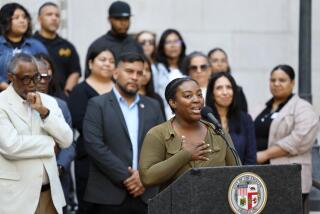WPA-Style Jobs Program Advances : Rebuilding: Senate panel approves proposal to hire welfare recipients for government jobs. Senator says Los Angeles would be ‘at the very top of the list.’
- Share via
WASHINGTON — Reviving a popular social program from the Great Depression, Congress is advancing a $400-million pilot project that would require welfare recipients and the unemployed in Los Angeles to work in government jobs rebuilding their communities.
The welfare reform legislation is a modern-day spinoff of President Franklin D. Roosevelt’s famous Works Progress Administration. The WPA paid more than 3 million of the nation’s unemployed to construct roads, bridges, airfields and schools between 1935 and 1943.
The current proposal, part of a $21.4-billion tax bill approved Wednesday by the Senate Finance Committee, would pay eligible welfare recipients in three selected cities and two states a 10% bonus on top of government assistance. In return, they would work in teams providing such services as rebuilding public parks, digging sewer trenches, painting murals and delivering hot meals.
“This is very ambitious,” said Sen. David L. Boren (D-Okla.), the architect of the legislation. “I just don’t think we have time to waste. One thing we are certain about is the current system is just not working.”
No cities or states are identified in the legislation, but Boren said it is a “virtual certainty Los Angeles would be at the very top of the list.”
Although the concept of putting welfare recipients to work is embraced by many experts in the social services field, some critics said Boren’s initiative is destined to fail.
“You can never get them off welfare with minimum wages,” said Alice Harris, executive director of the nonprofit organization Parents of Watts. “I was hoping they could give them a job, a trade where they could give them at least $10 to $12 an hour and 40 hours a week. But to give them a rake and 10% to shut their mouth up, I don’t think that will work. You have to give them pride.”
When the reform plan was introduced in March, Boren believed that it would take up to three years to get the pilot project enacted by Congress, he said. But, in the aftermath of the Los Angeles riots, the measure picked up momentum and sponsors within the Senate.
“Absolutely, the riot helped,” Boren said. “It symbolized the urgent need to do something and gave us a window of opportunity.”
Boren said he assembled a bipartisan coalition of supporters that included Sens. Lloyd Bentsen (D-Tex.), chairman of the committee; Paul Simon (D-Ill.), Carl Levin (D-Mich.), Bob Dole (R-Kan.), John W. Warner (R-Va.) and Arlen Specter (R-Pa.)
California’s senators, Democrat Alan Cranston and Republican John Seymour, were not among the initial sponsors.
Seymour has not had an opportunity to look at Boren’s legislation and has no position on it, said spokesman H.D. Palmer.
Cranston had several questions about the legislation and initially declined to sponsor it. “This is mandatory labor,” Cranston chief of staff Roy F. Greenaway said Wednesday. “We’re opposed to forced labor in China and other places in the world. Why shouldn’t we be opposed to it in the U.S.?”
Later on Wednesday, Cranston spoke with Boren and decided to sponsor the bill, but will try to change the coercive language, Cranston spokesman Phillip Tyson said.
The WPA was a nationwide program in which the unemployed built 650,000 miles of highways, 124,000 bridges, 125,000 public buildings and 39,000 schools and served more than 1 billion school lunches.
Results were mixed: Besides providing a paycheck to people who were destitute, the WPA fostered pride among legions of workers who built structures that still stand. In California, these include Long Beach Municipal Airport, Riverside County Hospital, Ontario City Hall and the Los Angeles Police Department gymnasium.
But critics called the program a giant boondoggle, citing its exorbitant cost and two congressional investigations.
Boren said he first thought of bringing back the WPA several years ago when he attended a political rally at a WPA project--the Pecan Bowl football stadium in Okemah, Okla.
“An elderly man in bib overalls came up to me and pointed to a stone retaining wall . . . he built through the WPA,” Boren said. “He had such tremendous pride in it. It knitted him to the community (and) made him feel forever a part of it.”
Boren’s legislation, called the Community Works Progress Demonstration Program, would award $100 million a year in grants between 1994 and 1997.
Individuals receiving Aid to Families With Dependent Children benefits and unemployment compensation are eligible for the program and must work, provided that enough jobs are available. Mothers with small children would not be required to work. Participants would be eligible for assistance to pay for child care, transportation and uniforms. Participants who refuse an available job would lose their benefits.
It is uncertain how the federal project would coordinate with GAIN (Greater Avenues for Independence), a mandatory welfare-to-work training program established in California in 1985 with a strong emphasis on education. In some areas, the state program also is required for nearly all adult welfare recipients except single mothers with very young children.
In Los Angeles, 309,241 people received AFDC benefits as of March, according to the Los Angeles County Department of Social Services.
The federal project would pay the AFDC grant or unemployment benefits plus 10% or the federal minimum wage, whichever is higher. As many as 30% of all workers in the project could receive higher wages for work that requires special skills or experience.
More to Read
Get the L.A. Times Politics newsletter
Deeply reported insights into legislation, politics and policy from Sacramento, Washington and beyond. In your inbox twice per week.
You may occasionally receive promotional content from the Los Angeles Times.









